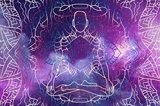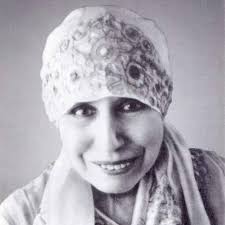Inner approach to health
Living the mantra
Abstract
Once the mantra is discovered, our life changes for good. An indelible link is created and an imprint is laid upon the soul. It becomes a true panacea for everyday living. The mantra possesses immense power and accompanies us through our lifetime and, in the case of japa, leads us right up to the threshold of transformation.
Mantra is my lifeline. It is the key that opens all the doors. Truly, it gives me everything I need; it keeps me going. Without it my life would have been sterile and meaningless. Once installed, there can be no turning back. Once discovered, everything can become so simple. The mantra, over time, builds momentum, supporting and sustaining us through life. We start living through it, although initially at least, it may not be so easy. The repetition is challenging enough, but it needs infusing with the greatest possible consciousness. Inevitably there will be times when limp and times of greater intensity. I feel a vivid sense of drift when the mantra lessers with the consciousness gravitating downwards. Our consciousness needs continuous tending. It is up to us to persistently bring the mantra to the forefront of our consciousness. Any slack and the focus and single-pointedness will disappear. For me, it is the mantra which elevates the consciousness and there is a feeling of immediate realignment whenever the practice is resumed: it is truly an exercise in living.
With mantra, the Word rises from the very depths of our being. It truly resonates inside. When uttered, it rises to the surface and calms my surface consciousness. Although the overall process can be very long, with continuity and persistence, it starts to settle and determine proceedings inside. The mantra starts to take over, align and organise our entire existence. It becomes our greatest friend and ally. Over time, it starts to automatically repeat itself. As we practise and evolve, we become conscious of this unique vibration, constantly present in the background. In times of adversity and crisis, it magically reappears. It creates homogeneity in our being. Very gradually the two parts — inner and outer — become one. It is remarkable how something so ‘exterior’ can manage all this!
As soon as it rises from inside, if the particular aspiration is present, it slowly acquires the capacity to change and mould the physical consciousness.There must be a yearning to change the physical consciousness for this to happen. We don’t want to be ‘saved’ from it: transformation, not salvation is our ultimate goal. The body responds to the repetition and being a creature of habit it resonates to this vibration. Recorded in various parts of Agenda, we read how the very body cells of the Mother were repeatedly calling for the Supreme Force and Light. The body can join in the mantra too....
I have found that continuous repetition has a way of annulling negativity. The habitual aspect of the mantra even breaks down and dissolves the habitual tendencies of our entire nature. It is a beautiful paradox. Repeating the sacred name through japa absolves and transforms the repetitive and negative mindset of the physical mind. The Mother says in Agenda that, “The japa is made precisely to control the physical mind (1).” With patience and perseverance it even enlightens the dark caverns of our subconscious. All throughout, the surface consciousness and the central being are joining together in collaboration: there is a growing sense of union. It is a process of education for the surface nature and it starts orienting more and more inside. The tune brings it ever closer to the psychic influence. That chaotic noise from the surface engine starts to stutter and over time finally stops.
The mantra can achieve all this. But how does it all start? It begins with awakening and aspiration. It is a spontaneous process. One awakens to the psychic influence and one day we may ask the Divine for this secret key, our own unique, eternal Word. Provided we are patient enough, the true answer will always come. So the words arise from within:
“Nobody can give you the true mantra. It’s not something that is given: it’s something that wells up from within. It must spring from within all of a sudden, spontaneously, like a profound, intense need of your being — then it has power, because it’s not something that comes from outside, it’s your very own cry (2).”
So we must be open to the influence of the soul, there must be some contact with it, otherwise the quest will be totally futile:
“But those who have no conscious contact with their soul cannot find their mantra — their head will search for words, but that’s nothing. I said the mantra must well up from within — but for them, nothing will well up! They won’t find it. They won’t find it, not a chance! So in that case, the guru passes on his own power (3).”
Mantra and its power
It is not so much the words that give the mantra its power. There needs to be Force behind and a flaming aspiration must inhabit the calling. This explains why the guru can provide it even if we can’t. It is sometimes a convenient substitution but this is one important reason why we should choose our guru very carefully. In a very vivid way, the mantra will define us and usually accompany us through the entire length of our life. We need to be clear about our true dharma and aim. We must have some inkling of our truth and its part in the manifestation. The mantra must fit our destiny. What we envisage will eventually take form. With the Supreme sanction anything is possible. Indeed it is ‘automatic’, but there is always a mutuality within the one reciting the mantra, that gives these words their enormous power:
“What counts is the sincerity of the aspiration, the exactness of the expression and the power; that is, the power that comes from the mantra being accepted. This is something very interesting: the mantra has been ACCEPTED by the Supreme Power as an effective tool, and so it automatically contains a certain force and power (4).”
Armed with this Force, the mantra seamlessly will preside over every activity of our day. For all action and work it is particularly helpful. The mantra provides effective protection against mishaps and accidents. It helps coordinate the senses and quietens any surface agitation. We can do our work in a more single-pointed way. With physical labour particularly, it helps keep our focus and attention on what is at hand. It places our poise firmly present in time and space. For more mental work however it is more challenging as the cerebral activity will attempt to blot out whatever it perceives as distractions. If we are not very vigilant it will easily succeed! There is so much interchange and prioritisation in this domain. The brain is not used to surrendering in what it considers to be its own backyard.
That is why I find it better to keep the mantra short and simple. It is not easy to integrate the mantra into office activity. At the beginning of our work, it is fruitful to enlist the Mother’s help to keep the continuity intact. Otherwise the consciousness gets crowded with deadlines and clutter. We have to trust and give priority to our mantra. The Mother herself recommends a short mantra, “one or two words, three at most”. The calling becomes more numerous and spontaneous. There are so many different situations where the mantra can be used; it can become our panacea for everyday living: “Because you must be able to use them in all cases, when an accident is about to happen, for example. It has to spring up without thinking. Like a reflex, exactly like a reflex. Then the mantra has its full force (5).”
Used in this context, the mantra becomes so adaptable and versatile: we find ourselves able to point it in whatever direction the aspiration faces. With the words constantly on our lips it can spring like a reflex to immediately address any situation that is at hand.
Japa
So this brings us to japa. It is quite extraordinary how much help practice affords. In a complete sense, it has become my ballast. Whenever things go awry, I return to it and normalcy returns. It has become the glue that holds me altogether. Japa can be recited out loud (vācika); distinctly pronounced but low, with only the lips moving upāmṣu or without any movement of the vocal organs or lips (acala-jihvṣ) (6). Above all, it is what keeps my body aligned and fortifies it with the faith and conviction that it can and must carry on. Sri Aurobindo has given me the framework from which to proceed:
“As a rule the only mantra used in this sadhana is that of the Mother or of my name and the Mother’s. The concentration in the heart and the concentration in the head can both be used — each has its own result. The first opens up the psychic being and brings bhakti, love and union with the Mother, her presence within the heart and the action of her Force in the nature. The other opens up the mind to self-realisation, to the consciousness of what is above mind, to the ascent of the consciousness out of the body and the descent of the higher consciousness into the body (7).”
The Mother says that japa is “an almost physical discipline. Moreover, I have seen that the japa has an organizing effect on the subconscient, on the inconscient, on matter, on the body’s cells — it takes time, but by persistently repeating it, in the long run it has an effect. It is the same principle as doing daily exercises on the piano, for example. You keep mechanically repeating them, and in the end your hands are filled with consciousness — it fills the body with consciousness (8).”
Japa benefits the whole nature in a myriad of ways, but its greatest boon is offered to the body. There can be no more meaningful work than this because the physical consciousness yearns for light and refinement. There is a secret aspiration there that drives our lives forward in the fullest and most integral way.
For one practising the sādhanā of the body, it is indispensable because no other tool can tackle these nether regions in a similar manner. When the japa is directed down onto the body the body starts calling itself…
“This is the main reason for my japa. There’s a power in the sound itself, and by forcing the body to repeat the sound, you force it to receive the vibration at the same time. But I’ve noticed that if something in the body’s working gets disturbed and I repeat my mantra in a certain way — still the same words, the same mantra, but said with a certain purpose and above all in a movement of surrender, surrender of the pain, the disorder, and a call, like an opening — it has a marvelous effect. The mantra acts in just the right way; in this way and in no other. And after a while everything is put back in order. And simultaneously, of course, the precise knowledge of what lies behind the disorder and what I must do to set it right comes to me. But quite apart from this, the mantra acts directly upon the pain itself (9).”
Quite apart from anything, whenever I work on the body, it is the japa that helps to keep my consciousness firmly placed upon it. Without it, there would be little focus. Otherwise the surface mind gets crowded with random and useless thoughts and the physical mind will project its futility onto the work. By calling Them, It no longer remains my action. It is out of my control: I am simply asking the Mother to walk my steps. This is the aspiration behind the words and the final result is always in Her hands.
There are times when the calling can become barren and dry and there are times when the practice requires some support:
“The japa is usually successful only on one or two conditions — if it is repeated with a sense of its significance, a dwelling of something in the mind on the nature, power, beauty, attraction of the Godhead it signifies and is to bring into the consciousness, — that is the mental way; or if it comes up from the heart or rings in it with a certain sense or feeling of bhakti making it alive, — that is the emotional way. Either the mind or the vital has to give it support or sustenance. But if it makes the mind dry and the vital restless, it must be missing that support and sustenance. There is, of course, a third way, the reliance on the power of the mantra or name in itself; but then one must go on till that power has sufficiently impressed its vibration on the inner being to make it at a given moment suddenly open to the Presence or the Touch... struggling or insistence for the result, then this effect which needs a quiet receptivity in the mind is impeded.” Mental quietude very necessary “and not too much straining or effort, to give time to allow the psychic and the mind to develop the necessary condition of receptivity… To spend all the energy in japa or meditation is a strain which even those who are accustomed to successful meditation find it difficult to maintain — unless in periods when there is an uninterrupted flow of experiences from above (10).”
There should be no strain with the mantra. The power of the name can quieten the mind and enlist the vital if it is sufficiently embedded in the being. Considerable initial effort is required at the beginning as these two instruments gradually learn to collaborate. A change of government is required. It takes time as we move forward but alternate between light and shadow. However, once the psychic being steps forward, the mantra becomes increasingly more automatic and, of itself, transforms into an overriding tool for progress.
There is a misconception that the mantra or japa doesn’t quite ‘fit’ the Integral Yoga. This is not surprising seeing as Sri Aurobindo stated, “In this yoga there is no fixed mantra, no stress is laid on mantras, although sadhaks can use one if they find it helpful or so long as they find it helpful. The stress is rather on an aspiration in the consciousness and a concentration of the mind, heart, will, all the being. If a mantra is found helpful for that, one uses it (11).”
However conditions have changed as the body itself has become more and more the arena for this yoga. It was the Mother who brought the yoga into the realm of the body cells. The body will be the crucible of the transformation and the time for the body is now:
“I have also come to realize that for this sadhana of the body, the mantra is essential. Sri Aurobindo gave none; he said that one should be able to do all the work without having to resort to external means. Had he reached the point where we are now, he would have seen that the purely psychological method is inadequate and that a japa is necessary, because only a japa has a direct action on the body….
In fact you can immediately see the difference between those who have a mantra and those who don’t. With those who have no mantra, even if they have a strong habit of meditation or concentration, something around them remains hazy and vague. Whereas the japa imparts to those who practise it a kind of precision, a kind of solidity: an armature. They become galvanized, as it were (12).”
Once we discover our mantra, our life changes for good. An indelible link is created and an imprint is laid upon our soul. I pray that the last words I utter in this lifetime will be my mantra. The mantra can be lived throughout the whole life-journey. The words can mirror our entire life destiny. In japa, it can even bring us to the threshold of transformation itself. Mantra is too great an opportunity to lose.
References
1. The Mother. Mother’s Agenda, Volume 1. Paris: Institut de Recherches Évolutives; English transl. 1979, p. 433.
2. The Mother. Mother’s Agenda, Volume 4. 1987, p. 130.
3. Ibid., p. 217.
4. The Mother. Mother’s Agenda, Volume 3.1982, p. 182-3.
5. The Mother. Mother’s Agenda, Volume 1, p. 196.
6. Pandit, MP. Japa. Pondicherry: Dipti Publications; 1991 reprint, p. 20.
7. Sri Aurobindo. Birth Centenary Library, Volume 23. Pondicherry: Sri Aurobindo Ashram Trust; 1970, p. 746.
8. The Mother. Mother’s Agenda, Volume 1, p. 421.
9. Ibid.,p. 379-80.
10. Sri Aurobindo. SABCL, Volume 23, p. 745.
11. Ibid. p. 746.
12. The Mother. Mother’s Agenda, Volume 1, p. 301.
James Anderson is a member of SAIIIHR and coordinating editor of NAMAH.
Share with us (Comments,contributions,opinions)
When reproducing this feature, please credit NAMAH,and give the byline. Please send us cuttings.







